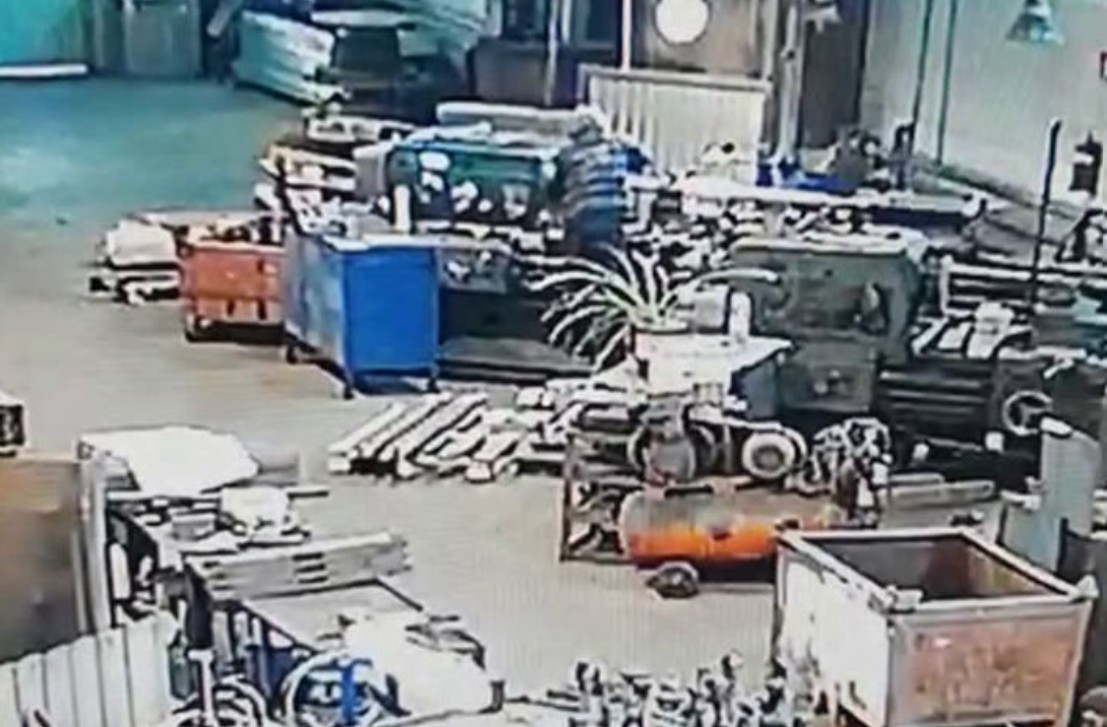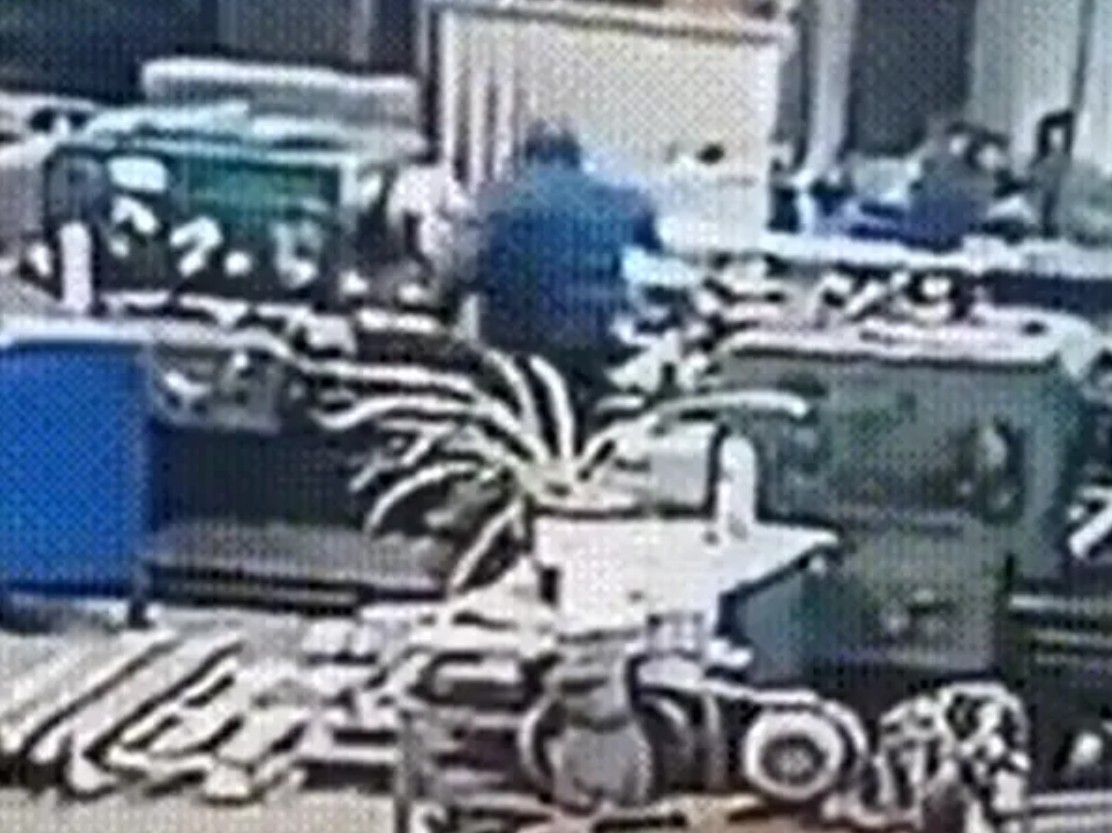In the high-risk world of industrial labor, especially in sectors dominated by heavy machinery, workplace accidents are a constant threat. These machines, while critical to modern production, do not discriminate between metal and flesh. One minor oversight, one lapse in attention, and tragedy can strike in the blink of an eye. Sadly, in the age of social media, many of these harrowing moments are caught on camera and widely shared online not for education, but often for shock value.

Recently, one such video has resurfaced and gone viral again. Known among internet users as the Russian Lathe Machine accident video, it shows a horrifying workplace tragedy where a man is sucked into a powerful industrial machine and killed in a matter of seconds. Originally posted two years ago on Reddit, the footage has once again grabbed the attention of thousands, garnering over 16,000 upvotes and nearly 2,000 comments, despite the original user having since deleted their account.
While disturbing and deeply unsettling, this incident serves as a powerful reminder of the dangers lurking in industrial settings. As terrifying as the footage may be, it presents a chance to learn and reflect on the importance of workplace safety.
Contents
- 1 Trigger Warning and Video
- 2 Understanding the Lathe Machine: A Powerful but Dangerous Tool
- 3 The Russian Lathe Machine Incident: What Happened?
- 4 Why Did This Happen? A Mechanical Analysis
- 5 The Aftermath and Impact
- 6 What Could Have Prevented It?
- 7 The Internet’s Role: Ethics of Viral Death Footage
- 8 Community Reactions and Reflections
- 9 What We Can Learn
Trigger Warning and Video
Before proceeding, a word of caution: this article contains graphic descriptions of a fatal workplace accident involving blood and bodily harm. If you’re sensitive to such content or find it emotionally distressing, please consider whether you wish to continue reading.
This article is not meant to sensationalize tragedy but to highlight the severe consequences of industrial negligence and the vital need for safety protocols in hazardous work environments.
Understanding the Lathe Machine: A Powerful but Dangerous Tool
The lathe machine is one of the oldest and most widely used mechanical devices in history. Often referred to as the “Mother of All Machine Tools,” the lathe has a long legacy of shaping raw materials into precise, symmetrical forms. It works by rotating a workpiece on its axis while various tools perform actions such as cutting, drilling, sanding, or turning.
These machines are used in numerous industries, including:
Metalworking
Woodturning
Pottery and Ceramics
Automotive and Aerospace Manufacturing
Some of the common objects produced using lathe machines include gun barrels, screws, engine parts, and baseball bats. Because of the precision and force involved in their operation, lathe machines require rigorous attention to safety and proper training for all operators.
The Russian Lathe Machine Incident: What Happened?
The viral video that reignited public attention shows a man working in a Russian industrial facility filled with various types of machinery. Surveillance-style footage captures him walking near an active lathe machine, appearing unaware that it is already powered on.

Tragically, he makes physical contact with the rotating part of the lathe possibly attempting to inspect or adjust it. Within seconds, the spinning force of the machine grabs his hand and pulls his entire body into the device with horrifying speed. His body is violently shredded, and the scene quickly becomes a blur of flying debris and blood.
Though the first few moments seem to indicate the injury might be isolated to his hand, it’s clear moments later that the full force of the machine has torn him apart completely. Another individual eventually enters the room, reacts in visible shock, and rushes to turn the machine off. But by then, it’s far too late. The man is already dead his body dismembered beyond recognition.
Why Did This Happen? A Mechanical Analysis
The lathe machine is engineered to deal with high-resistance metal materials. Its rotating parts are powered by motors capable of enduring immense torque and force without slowing down. This durability is what makes them ideal for shaping hard surfaces, but also what makes them extremely dangerous to humans.
As Reddit user PRUnicycles explains in a comment:
“The force required to remove the material is incredibly high, so the machine is designed to clamp that metal and continue to spin, even with high resistance. This guy got too close to the spinning part and got caught, it continued to spin and pull him into the machine. His body couldn’t compete with the G force, so it tore apart.”
Another Redditor, Th3XRuler, put it more bluntly:
“Machines built to chew up metal will not stop for a human.”
In short, the moment the man’s body touched the moving part, the lathe machine reacted exactly as it was built to, to grind through resistance. It made no distinction between a metal object and a human being.
The Aftermath and Impact
The immediate consequence of the accident was, of course, the loss of life. The victim was torn apart in seconds. But the trauma didn’t end there. The man who discovered the scene and turned the machine off may be scarred psychologically for life.
For online viewers, the impact varied. Some felt horrified and regretful after watching the footage, admitting they clicked out of curiosity and were unprepared for the severity of the content. Others pointed out that such videos though disturbing serve as a powerful cautionary tale for both industrial workers and general audiences.
What Could Have Prevented It?
This tragedy was not inevitable. Experts agree that multiple layers of safety could have prevented the loss of life:
1. Training
The victim may have lacked proper training or awareness of the machine’s status.
Comprehensive training for all personnel should be a non-negotiable standard.
2. Safety Barriers and Guards
Physical guards over rotating parts can prevent accidental contact.
Proximity sensors could have alerted others if someone got too close.
3. Emergency Shut-off Switches
Easily accessible emergency stops can save lives every second counts.
In this case, the time delay in stopping the machine proved fatal.
4. Warning Systems
Visual and auditory alerts when the machine is operational.
Clear signage indicating the dangers.
5. Supervision
High-risk operations should never be conducted alone.
A supervisor or buddy system might have changed the outcome.
The Internet’s Role: Ethics of Viral Death Footage
This incident, like many others, raises serious ethical concerns about the spread of graphic content online. While Reddit has a system of tagging NSFW (Not Safe for Work) and potentially disturbing content, it doesn’t prevent users from reposting or resharing horrific videos.
Pros of sharing the video:
Raises awareness of workplace hazards.
Educates people on the power and danger of industrial machinery.
May influence stricter safety measures.
Cons of sharing the video:
Desensitizes viewers to real human suffering.
Disrespects the dignity of the deceased.
Can traumatize viewers, especially those unprepared for the content.
There is an urgent need for better content moderation policies, alongside ethical discussions about when and why such footage is necessary.
Community Reactions and Reflections
The Reddit thread hosting the video was filled with a range of emotional responses:
Shock and sadness: Users expressed horror at how quickly a life could end due to negligence.
Insightful commentary: Professionals in engineering and manufacturing offered detailed mechanical explanations.
Personal accounts: Some shared similar near-miss incidents in their workplaces.
Calls for reform: Many demanded better workplace training and stricter enforcement of industrial safety standards.
What We Can Learn
While it’s easy to label such incidents as freak accidents, the reality is that they are preventable tragedies. The Russian Lathe Machine incident should serve as a wake-up call not just for factory workers, but for everyone involved in industrial design, policy, and safety enforcement.
Human lives are far more fragile than we realize. In an environment designed to mold, cut, and crush metal, a moment’s carelessness can end everything. The machines aren’t evil they’re indifferent. The responsibility lies with us to respect their power and build safety into every step of our processes.
The Russian Lathe Machine video is not just another piece of viral content it’s a brutal snapshot of what happens when human error meets mechanical force. The footage may be disturbing, but the lesson it delivers is critically important.
Workplace safety isn’t just a formality it’s a matter of life and death. We owe it to every worker, every family, and every life lost to take these lessons seriously and strive for a safer, more vigilant world.




